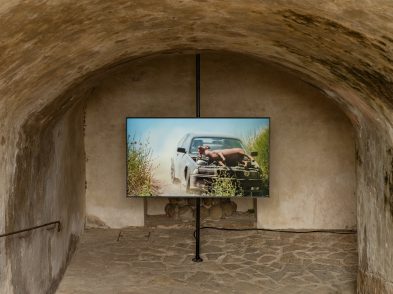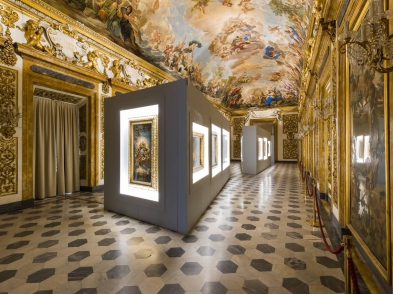As an artist, Robert Rauschenberg’s radical objective was to operate “in the gap between art and life”. His work crossed boundaries and a major retrospective at London’s Tate Modern (touring to New York and San Francisco) confirms that, although he died in 2008, this innovative figure remains a strong influence, especially on young artists. But before his fame became global, one of his first exhibitions took place in Florence in 1953—and it culminated in a gesture that has become an art legend.
One Sunday in mid-March 1953, two young American artists exhibiting their work in Florence took a walk along the Arno to a secluded spot where the water was deep. History does not record whether, on reaching that point, they ate the “lovely picnic” they had prepared, or of what it consisted. But one incident that morning has become a legend of modern art. For, out of sight of passers-by, one of the men took a bundle—it was probably quite large—and threw the contents into the river.
His name was Robert Rauschenberg. He was 27 and as an exhibitor, he was almost untried. His first one-man show had taken place in a New York gallery two years earlier and had left critics uncertain and bewildered.
The bundle that plummeted into the water contained most of the artworks in his first Florence exhibition. Rauschenberg had collected them from the gallery at lungarno delle Grazie 10, a few doors from the Uffizi. He took care to ensure that the objects would sink into the river mud. They never resurfaced.
Soon after, both men began their journey back to the United States on the SS Andrea Doria, bringing to an end their seven-month sojourn in the old world, most of it spent in Italy.
But why did it close with this dramatic gesture?
History shows that the visit was a formative experience for both men. Rauschenberg had travelled with his companion that morning in Florence, Cy Twombly. At 24, Twombly’s slender reputation rested on two one-man exhibitions. Then, armed with a grant on which both travellers depended, he embarked for Italy.
Rome was a revelation to them.
“It’s been like one enormous awakening of many wonderful rooms in a house I never knew existed,” Twombly wrote a few months after sailing back to New York. Borrowing money from friends, he returned in 1957 and settled in Italy, marrying an aristocrat. Cutting himself off from his generation of American artists, Twombly rooted his expressive abstract painting in ancient traditions and, by the time of his death in 2011, achieved international acclaim.
Rauschenberg had no intention of staying in Italy. When he had left New York the previous August, his career was in the doldrums and he was shaken and depressed by his impending divorce. In the ensuing months he travelled to Tuscany, Assisi and Venice, and worked for a period in Morocco for the cash both men desperately needed, returning to Rome through Spain. In the process, he encountered the cultural heritage of Europe at first hand.
Acknowledged as among the most significant artists of the last century, he became increasingly attached to the force of classical myth—and always approached it in new ways. He quoted Renaissance imagery on numerous occasions: just two years after returning from Italy, he inserted a reproduction of Botticelli’s Birth of Venus, the original of which he first saw in the Uffizi, into his breakthrough “combine” painting, Rebus (1955)—an aggressive mix of materials (oil, paper, fabric, pencil, crayon, newspaper and printed images) and cultural references.
His 1953 exhibition in Florence was no less unorthodox and for the city’s conservative art establishment, it was a provocative introduction to the iconoclastic Texan.
Titled “Scatole e Costruzioni Contemplativi”, the show comprised two groups of works that took shape as he and Twombly travelled. The “scatole” were pocket-sized wood boxes, satin-lined purses and metal crystal cases. Portable and lightweight, they resembled a boy’s private museum: little compartments were filled with a random mix of items and artefacts casually collected at flea markets or from the street.
He first exhibited them in Rome a fortnight before his opening in Florence, and listed for visitors many of the materials involved, adding reasons for choosing them: “for … the richness of their past: like bone, hair, faded cloth and photos, broken fixtures, feathers, sticks, rocks, string, and rope; or for their vivid abstract reality: like mirrors, bells, watch-parts, bugs, fringe, pearls, glass, and shells.”
Like the boxes, the “costruzioni contemplativi” were assembled from ingredients he bought or found, then selected and combined. But these objects were even more unusual, partly because they were not hung on a wall but were suspended in space on strings. Rauschenberg also called them his “feticci personali” (personal fetishes). With flowing mains of animal hair, bones, beads and shiny curios, critics inevitably dubbed them “surreal” and “primitive”, like symbols of a remote exotic culture. The artist offered no illusions; they had “rich false histories”, he wrote. He liked their sound and movement as elements jingled in draughts and caught the light. He photographed the fetishes dangling from trees in Rome’s Pincio gardens, hooked over furniture at his pensione and draped from antique statuary like votives in a ritual.
The photographs are the only record now of their appearance. Playful and serious at the same time, the fetishes were artistically inventive as expressions of creative liberty. As his individual response to the visually unfamiliar surroundings of Europe and North Africa, they effortlessly blurred distinctions between sculpture, decoration, art and craft.
The Rome audience greeted the boxes and fetishes with informed amusement; to the surprise of gallery and artist alike, some boxes even sold. (The artist kept a few more.) But in Florence, the press was at best cautious—and one critic was openly hostile.
The exhibition opened on March 14 at a venue prepared for risks. Galleria d’Arte Contemporanea, now largely forgotten, was ambitious and ultimately short-lived; its proprietors, both in their twenties, were attuned to progressive contemporary experiments. One owner was Martin Krampen, a theology and psychology graduate from Germany who moved to Florence in 1950 to study painting at the Accademia. His partner was artist Paola Mazzetti, a name well known after 1961 when her twin Lorenza published Il cielo cade (The Sky Falls). The book recounted tragic events in August 1944 when the sisters’ aunt and two cousins, with whom they were staying, were murdered at Rignano sull’Arno by retreating Nazi troops.
A year later, their grief-stricken uncle Robert Einstein, the physicist’s brother, took his own life.
The gallerists’ decision to show Rauschenberg’s objects in Florence was bold, as was the artist’s open mind to visitors’ responses. In Rome he had invited them to “add bits of your own choice” and to rearrange the contents of boxes to “develop your own ritual about the objects” as if ascribing an independent force to his materials. His attitude to the Florentine public would have been identical.
The writer in Florence’s Il Mattino dell’Italia Centrale warned that the show “will disconcert the unwary visitor”, while an unsigned review in La Nazione regarded “this interesting surrealist exhibition” as “evidence of an imaginative sensibility verging on distressing oddity”. One august art historian in Il Nuovo Corriere stressed the work’s “trembling vocabulary of barbaric metaphysics”.
But another complaint precipitated Rauschenberg’s exceptional riposte.
He recalled the episode some years later: “The town’s most important critic came to look at the show. He remarked that it was a beautiful day, he emphasised the beauty of the Uffizi, then hurled abuse at my work: he said it was psychological garbage and that it must be thrown into the Arno.
I followed his suggestion.”
Rauschenberg once described this unorthodox donation of artwork to Florence as a “Dadaist act”, citing the art revolutionaries of early last century whose art, poetry and, above all, performances were often satirical and nonsensical. Perhaps that was true. Or maybe his personal fetishes had unlocked an aspect of himself too deep to preserve. “Their emptiness,” he had written in Rome, “signifies unknown possibilities.” He did not display the work he saved for 20 years. So one bad review and the Arno’s strong current offered the opportunity to break with them. And, as Rauschenberg reflected over 20 years later, “it saved the packing problem.”






